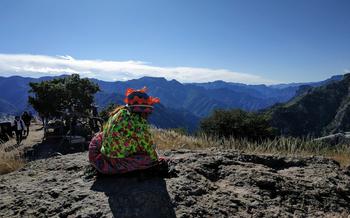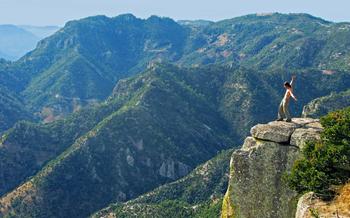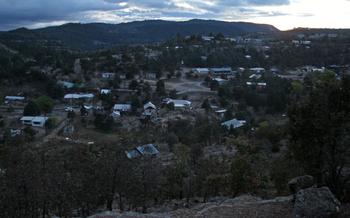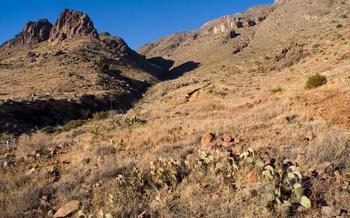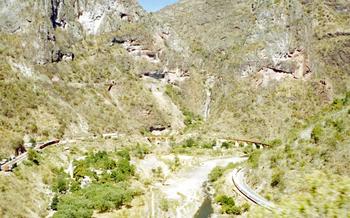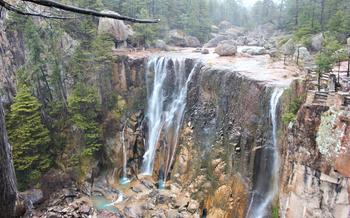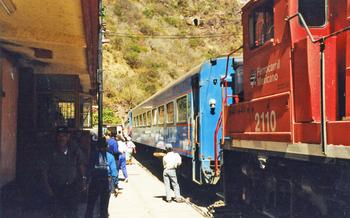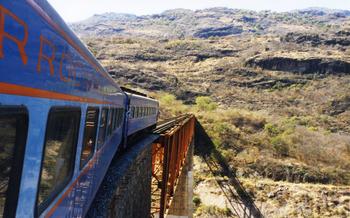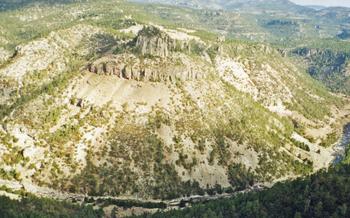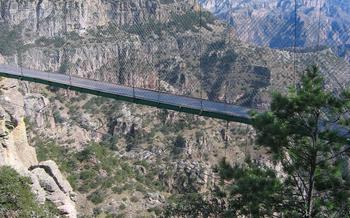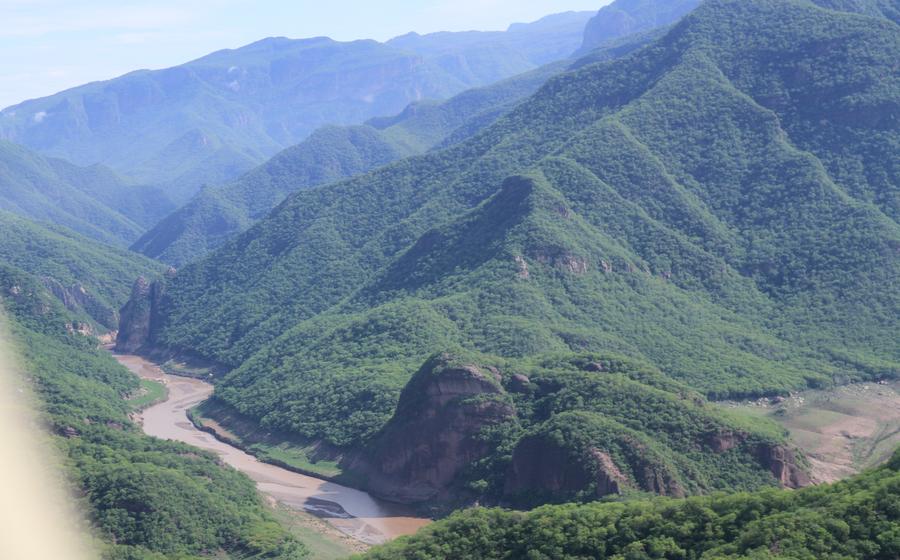
Chinipas River
- Copper Canyon Overview
- Chinipas River: A Natural Wonder
- Getting to the Chinipas River
- Best Time to Visit
- Chinipas River Activities
- Local Cuisine
- Accommodation Options
- Safety Precautions
- Cultural Experiences
- Photography Opportunities
- Hiking Trails
- River Tours
- Wildlife Encounters
- Camping and Backpacking
- Insider Tip: The Lost Waterfall of Batopilas
Copper Canyon Overview
Nestled amidst the rugged Sierra Madre Occidental mountain range in northwestern Mexico, Copper Canyon, or Barrancas del Cobre, is a breathtaking natural wonder that rivals the grandeur of the Grand Canyon in the United States. With a depth of over 1,800 meters (6,000 feet) and a length of over 600 kilometers (370 miles), it is the largest canyon system in North America and one of the most awe-inspiring natural attractions in the world.
The history of Copper Canyon dates back millions of years to the geological processes that shaped the region. The relentless forces of erosion carved deep canyons and gorges into the earth's surface, revealing layers of colorful rock formations and creating a landscape of unparalleled beauty. The area has been inhabited by indigenous communities for centuries, who have preserved their traditions and way of life amidst the rugged terrain.
In recent years, Copper Canyon has emerged as a popular tourist destination, attracting visitors from around the world who come to witness its natural wonders. The region offers a diverse range of activities, from scenic train rides and hiking trails to whitewater rafting and zip-lining. Whether you're seeking adventure, relaxation, or cultural immersion, Copper Canyon has something to offer everyone.
Chinipas River: A Natural Wonder
The Chinipas River, flowing through the heart of the Copper Canyon, stands as a testament to the region's natural splendor. Originating in the Sierra Madre Occidental, this mighty river carves its way through rugged canyons, creating a breathtaking landscape that draws adventurers and nature enthusiasts from around the globe. The river's crystal-clear waters, cascading waterfalls, and lush riparian vegetation provide a habitat for diverse flora and fauna, making it a haven for wildlife enthusiasts.
As the lifeblood of the region, the Chinipas River plays a crucial role in sustaining the local ecosystem. Its waters irrigate fertile farmlands, supporting agriculture and providing sustenance to the communities that call the canyon home. The river also serves as a source of drinking water and supports a thriving fishing industry, providing livelihoods for many locals.
Historically, the Chinipas River has been a vital transportation route, connecting remote villages and facilitating trade. Its significance extends beyond its practical uses, as it holds deep cultural and spiritual meaning for the indigenous communities that have inhabited the region for centuries. The river is considered a sacred entity, revered for its life-giving properties and its connection to the ancestral traditions of the native peoples.
Getting to the Chinipas River
Reaching the Chinipas River offers travelers a scenic and adventurous journey. Several options are available for those seeking to explore this natural wonder.
For public transportation, travelers can take a bus from major cities in the region, such as Chihuahua or Los Mochis. The buses typically depart in the morning and arrive in the afternoon, providing a comfortable and affordable way to reach the river. Alternatively, private transportation is an excellent option for those who prefer a more flexible and personalized experience. Renting a car allows for the freedom to explore the region at your own pace, making stops at various points of interest along the way.
For those who enjoy road trips, the Copper Canyon Scenic Route is a must-drive. The route winds through the rugged landscapes of the canyon, offering breathtaking views and opportunities to encounter local communities and immerse in the region's rich culture. Along the way, travelers can stop at picturesque viewpoints, visit historical sites, and experience the warmth and hospitality of the local people.
Best Time to Visit
The best time to visit the Chinipas River is during the dry season, which runs from October to May. During this time, the weather is generally sunny and dry, with average temperatures ranging from 15 to 25 degrees Celsius. This makes it ideal for outdoor activities such as kayaking, white-water rafting, and hiking.
The rainy season, from June to September, can also be a good time to visit if you don't mind getting wet. The river swells during this time, creating powerful rapids that are perfect for white-water rafting. However, it's important to be aware that the weather can be unpredictable during the rainy season, with heavy rains and occasional flooding.
If you're interested in experiencing the local culture, there are several festivals and events that take place in the region throughout the year. The most popular is the Chinipas River Festival, which is held every year in October. This festival celebrates the river and its importance to the local community, with traditional music, dancing, and food.
Chinipas River Activities
The Chinipas River offers a wealth of exciting activities for outdoor enthusiasts and nature lovers. Kayaking and white-water rafting are popular choices for those seeking an adrenaline rush. The river's crystal-clear waters and varying rapids provide an exhilarating experience for paddlers of all skill levels. Numerous tour operators offer guided trips, ensuring a safe and enjoyable adventure.
For those who prefer a more tranquil experience, fishing and birdwatching are excellent options. The river is home to a diverse range of fish species, including trout, bass, and catfish, making it a paradise for anglers. The surrounding forests and wetlands are teeming with an abundance of birdlife, providing excellent opportunities for birdwatchers.
Swimming and sunbathing are also popular pastimes along the river. Several sandy beaches and secluded spots invite visitors to relax and soak up the sun's warmth. The river's refreshing waters offer a welcome respite from the heat, making it a perfect spot to cool off and escape the summer's heat.
Local Cuisine
The region surrounding the Chinipas River is renowned for its rich culinary traditions, influenced by the diverse cultures that have shaped its history. One of the must-try dishes is "caldo de res", a hearty beef stew made with fresh vegetables and aromatic spices. For a taste of local seafood, indulge in "ceviche de sierra", a refreshing ceviche prepared with tender fish marinated in lime juice, cilantro, and onions.
Local markets are a treasure trove of culinary delights, offering an array of fresh produce, handmade tortillas, and regional specialties. Don't miss the chance to sample "tacos de barbacoa", slow-cooked barbacoa meat served in warm tortillas with salsa and guacamole. For a sweet treat, try "cajeta de membrillo", a traditional quince paste dessert with a unique flavor.
Accommodation Options
When planning a trip to the Chinipas River, travelers have a range of lodging options to choose from. For a comfortable and luxurious stay, several hotels and lodges offer modern amenities, including private balconies or patios with breathtaking views of the river and surrounding mountains. These establishments often feature swimming pools, restaurants, and tour desks to assist guests in planning activities.
For those seeking a more immersive experience, there are charming guesthouses and bed and breakfasts run by local families. These accommodations provide a glimpse into the region's culture and traditions, allowing guests to interact with the warm and welcoming people of the area. Budget-conscious travelers can opt for hostels or campsites, which offer basic yet comfortable accommodations at affordable rates.
To find the most suitable accommodation, it's advisable to consider factors such as budget, desired amenities, and proximity to specific attractions or activities. Advance booking is recommended during peak season to secure the preferred choice of lodging.
Safety Precautions
When exploring the Chinipas River and the surrounding areas, it's essential to prioritize safety. Here are some general tips to ensure a safe and enjoyable trip:
-
Be aware of your surroundings. Pay attention to your surroundings, especially when hiking or exploring remote areas. Let someone know your planned route and expected return time.
-
Respect local customs and traditions. Familiarize yourself with the local culture and customs to avoid any misunderstandings or disrespectful behavior.
-
Be prepared for emergencies. Carry a basic first-aid kit and essential supplies, including water, snacks, and a flashlight. Know how to contact emergency services if needed.
-
Avoid swimming in certain areas. Some parts of the river may have strong currents or hidden dangers. Ask locals or consult with tour operators about safe swimming spots.
-
Stay hydrated. The weather in the Copper Canyon can be hot and dry, so drink plenty of water to stay hydrated and avoid dehydration.
-
Protect yourself from the sun. Wear sunscreen, sunglasses, and a hat to protect yourself from the sun's harmful UV rays.
-
Be cautious of wildlife. While wildlife encounters can be exciting, remember that wild animals are unpredictable. Maintain a safe distance and avoid feeding or approaching them.
Cultural Experiences
The Copper Canyon region is home to a diverse mix of indigenous communities, each with its unique customs and traditions. The Tarahumara, or Rarámuri, are the most well-known indigenous group in the area, renowned for their traditional way of life and their skill as long-distance runners. Visitors can interact with the Tarahumara people by visiting their villages, attending their festivals, or hiring them as guides for hiking or horseback riding excursions. Other indigenous groups in the region include the Tepehuán, the Pima, and the Mayo, each with their own distinct cultural heritage. Travelers who are interested in experiencing the rich cultural diversity of the Copper Canyon should make an effort to connect with the local communities and learn about their customs and traditions.
Photography Opportunities
The Chinipas River presents a photographer's paradise, with its breathtaking landscapes, diverse wildlife, and vibrant cultural scenes. Capture the essence of the region by venturing off the beaten path and exploring hidden waterfalls, secluded canyons, and remote villages. The river's crystal-clear waters offer stunning reflections, while the lush vegetation provides a vibrant backdrop for your shots. Don't miss the opportunity to photograph the local people, whose warm smiles and traditional attire add a human touch to your images. Remember to be respectful of their privacy and ask for permission before taking their pictures. As the sun sets, the sky transforms into a canvas of vibrant colors, painting a magical scene that's worth capturing. With its endless photo opportunities, the Chinipas River is a dream destination for nature and culture enthusiasts alike.
Hiking Trails
The Chinipas River offers a variety of hiking trails that cater to various skill levels and interests. These trails wind through the stunning landscapes, showcasing diverse ecosystems and providing opportunities for wildlife encounters. One of the most popular trails is the Copper Canyon Trail, which traverses the rim of the canyon and offers breathtaking panoramic views. The Cascada de Basaseachi Trail leads to the stunning Basaseachi Waterfall, the highest waterfall in Mexico. For those seeking a challenging hike, the Sierra Tarahumara Traverse is an epic multi-day trek that takes hikers through the heart of the mountain range.
Each trail offers its unique challenges and rewards, with well-marked paths and estimated hiking times provided for guidance. Along the way, hikers can discover hidden waterfalls, lush forests, and scenic viewpoints that capture the essence of the Copper Canyon. Whether you're a seasoned hiker or just starting out, there's a trail here to suit your abilities and provide an unforgettable hiking experience.
River Tours
Exploring the Chinipas River by embarking on an organized tour or guided excursion offers several advantages. These tours are led by experienced guides who possess a wealth of knowledge about the river's history, ecosystem, and wildlife. They can provide insights and share stories that enhance the overall experience for visitors.
Joining a guided tour eliminates the hassle of planning and navigation, as the guides take care of the logistics and ensure a safe and enjoyable journey. They can also recommend the best spots for swimming, wildlife viewing, and photography, ensuring that visitors make the most of their time on the river.
Several reputable tour operators in the area offer a range of options, from short sightseeing cruises to multi-day expeditions. These tours vary in duration, difficulty level, and price, catering to different interests and budgets. Some popular tour operators include:
- Sierra Madre Adventure Tours: Offers guided kayaking and white-water rafting trips, as well as hiking and cultural immersion experiences.
- Ecoturismo Barrancas del Cobre: Specializes in sustainable and eco-friendly tours, including boat trips, birdwatching excursions, and visits to local communities.
- Chinipas River Expeditions: Provides customized tour packages that can be tailored to specific interests, including wildlife photography, fishing, and historical exploration.
Booking a guided tour is highly recommended for first-time visitors or those who want to delve deeper into the cultural and natural wonders of the Chinipas River.
Wildlife Encounters
The Chinipas River is a haven for wildlife enthusiasts, offering a chance to witness a diverse range of flora and fauna in their natural habitat. The region is home to over 300 species of birds, including colorful parrots, majestic eagles, and elusive owls. Birdwatching enthusiasts can embark on a guided tour or explore the riverbanks independently, capturing stunning photographs of these magnificent creatures.
The river's crystal-clear waters are teeming with fish, making it a popular destination for anglers. Fly fishing and bait casting are popular techniques, and visitors can expect to catch a variety of species, including trout, bass, and catfish.
The surrounding forests and canyons are home to an abundance of mammals, including deer, coyotes, and bobcats. Keep an eye out for these elusive creatures as you hike along the riverbanks or camp in the backcountry.
The Chinipas River is also home to a variety of reptiles and amphibians, including snakes, lizards, and frogs. While some species are venomous, most are harmless and can be observed from a safe distance.
To ensure a safe and ethical wildlife viewing experience, remember to maintain a respectful distance from animals, avoid disturbing their natural behavior, and dispose of waste responsibly. By following these guidelines, you can help protect the delicate ecosystem of the Chinipas River while enjoying the wonders of its wildlife.
Camping and Backpacking
Camping amidst the stunning landscapes of the Chinipas River offers a unique opportunity to immerse yourself in nature's tranquility. Designated campgrounds provide सुविधाएं such as restrooms, picnic tables, and fire pits, ensuring a comfortable stay. If you're seeking a more adventurous experience, backcountry camping is permitted in designated areas, allowing you to explore the river's pristine wilderness.
When planning your camping trip, come prepared with essential gear, including a tent, sleeping bag, cooking equipment, and a first-aid kit. Always pack sufficient water and food, as supplies are limited in the area. Responsible camping practices are crucial to preserve the environment. Leave no trace by properly disposing of waste, minimizing campfire impact, and respecting wildlife.
Camping along the Chinipas River is an experience that will leave you with lasting memories. Embrace the solitude, marvel at the starry night sky, and awaken to the symphony of birdsong. Whether you prefer the comfort of a campground or the thrill of backcountry camping, the Chinipas River promises an unforgettable adventure.
Insider Tip: The Lost Waterfall of Batopilas
Venturing off the beaten path in Copper Canyon leads to the hidden gem known as the Lost Waterfall of Batopilas. This secluded cascade is tucked away in the rugged mountains, requiring a moderate hike to reach. The trail meanders through dense vegetation and offers glimpses of the surrounding canyons before revealing the breathtaking waterfall.
The Lost Waterfall cascades down a sheer rock face, creating a mesmerizing spectacle. The surrounding amphitheater of cliffs amplifies the roar of the water, creating a symphony of sound. The mist from the waterfall creates a refreshing atmosphere, making it an ideal spot to relax and soak in the tranquility.
The Lost Waterfall is a true hidden gem, offering a unique and rewarding experience for those willing to explore beyond the usual tourist trail. The hike to the waterfall is suitable for moderately fit individuals and provides an opportunity to immerse oneself in the natural beauty of Copper Canyon.
